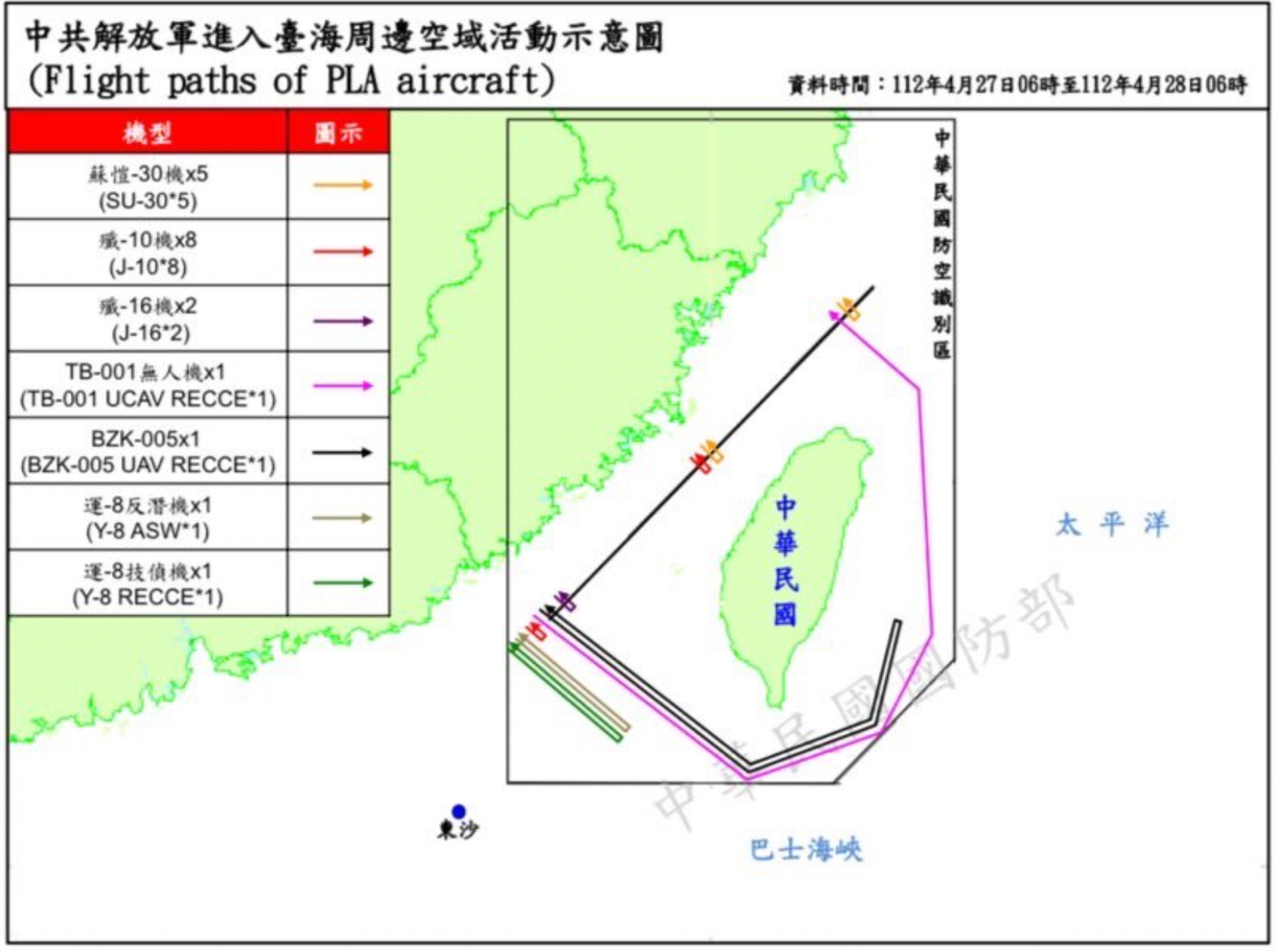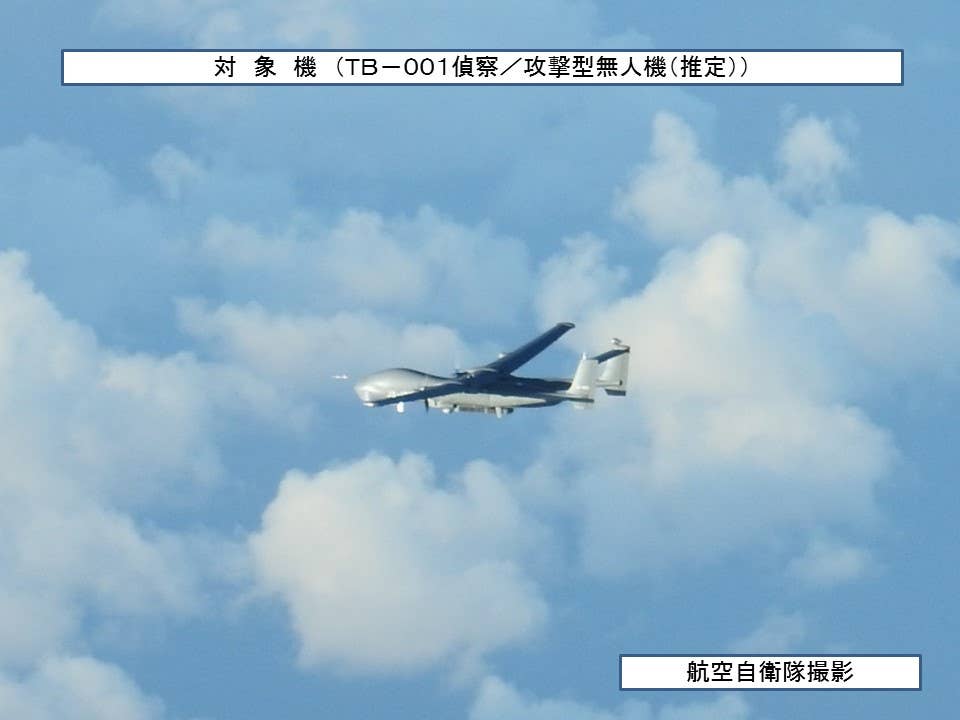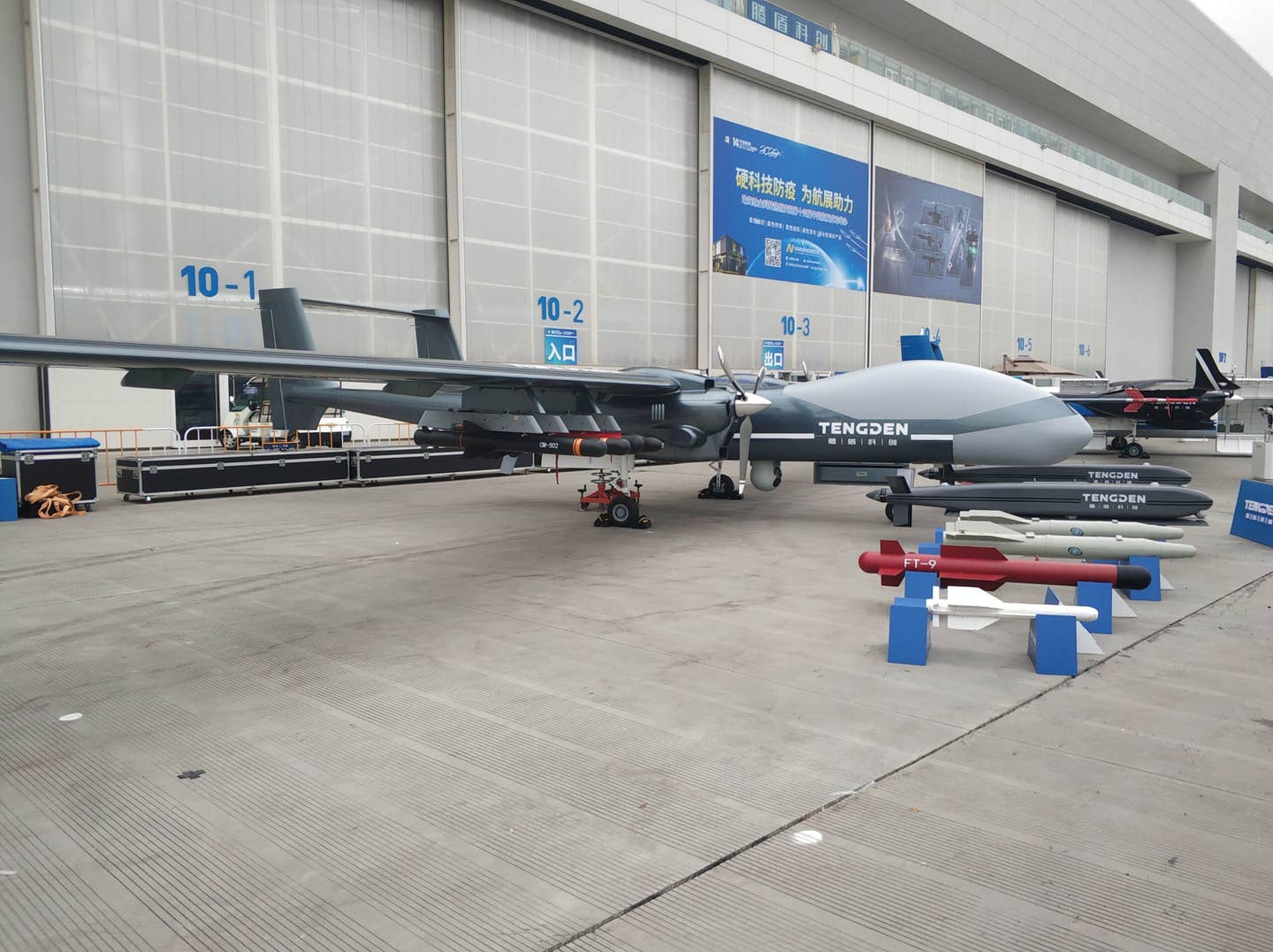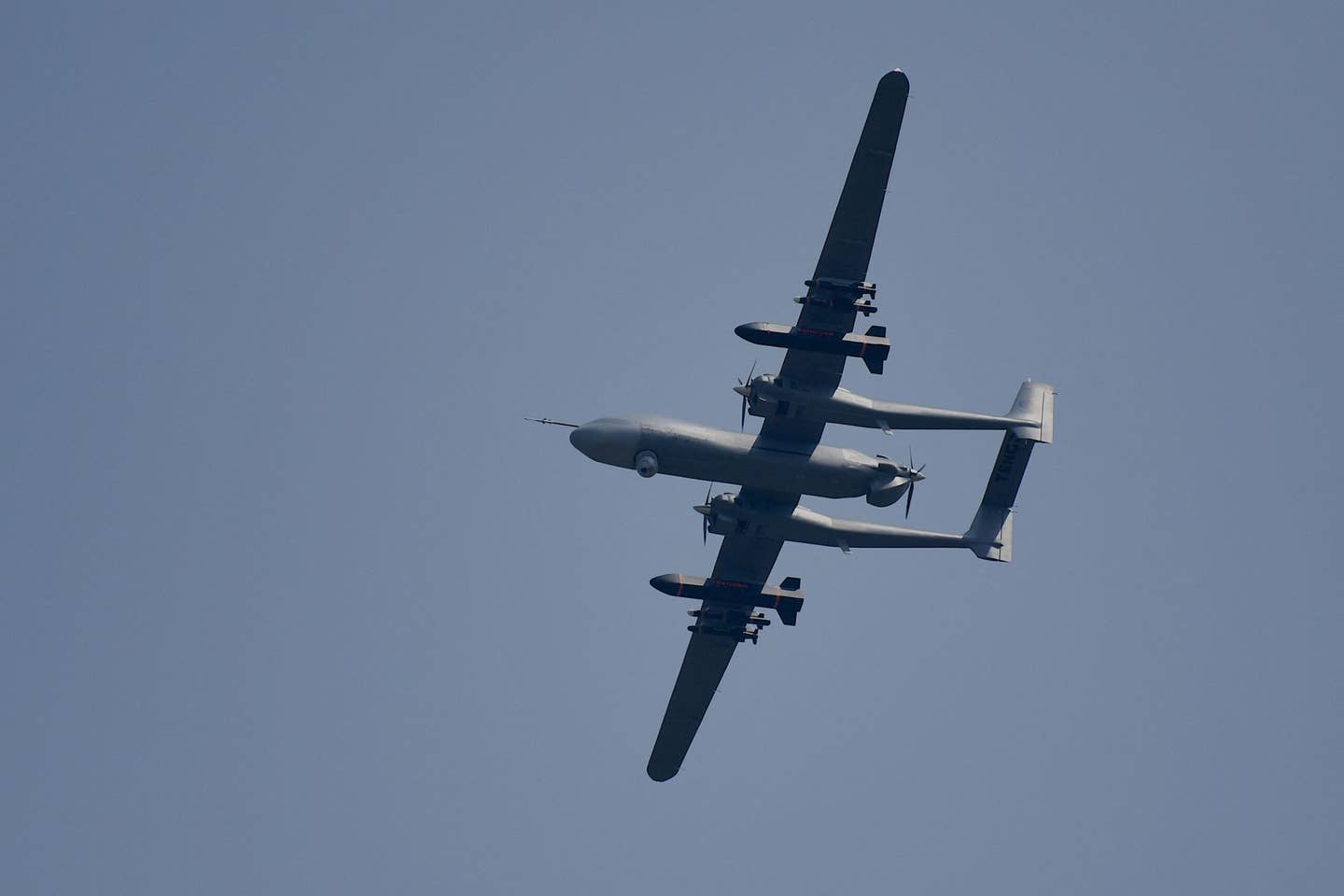Chinese TB-001 Scorpion Drone ‘Encircled’ Taiwan
In an apparent new development, the long-endurance drone, which can carry weapons, flew a mission taking it up the east coast of Taiwan.
"A Chinese TB-001 Scorpion medium-altitude, long-endurance (MALE) drone has flown an apparently unprecedented mission around Taiwan, according to authorities on the island. The drone sortie came as part of the latest spike in Chinese People’s Liberation Army (PLA) air and naval activity in the Taiwan Strait, something that has become more commonplace in recent months. However, according to local reports, this is the first time that Taiwan's Ministry of National Defense has publicly acknowledged that a PLA aircraft ‘encircled’ the island in this way.
The Scorpion drone first crossed the Bashi Channel that separates Taiwan from the Philippines, then headed up the east coast of the island, before crossing back toward the Chinese coast, according to a press release from the Taiwanese Ministry of National Defense. Another Chinese MALE drone, a BZK-005, also flew part of the way around Taiwan on a similar course but turned back roughly halfway between the island and the median line that serves as a de facto boundary between it and the mainland.
The two drones were part of a group of 38 PLA aircraft that the Ministry of National Defense says it detected around Taiwan in the 24 hours leading up to 6:00 A.M. local time today.
Of those aircraft, the Taiwanese defense ministry says that 19 crossed the median line of the Taiwan Strait or entered Taiwan’s southwest, southeast, and northeast Air Defense Identification Zones, or ADIZ. While it’s not uncommon for PLA aircraft to cross the median line, the scale of such activity has increased notably in recent times. The ADIZ is a broader area Taiwan monitors and patrols and it’s worth noting that this covers not only the entirety of the strait but also portions of mainland China, too.
As well as the two drones, the 19 aircraft specified as having crossed the median line and/or entered the ADIZ comprised five Su-30 and two J-16 Flanker fighter jets, eight J-10 fighter jets, a single example of the Y-8 anti-submarine warfare aircraft, and another, reconnaissance-configured Y-8 variant.
“[The] Republic of China Armed Forces have monitored the situation and tasked CAP [combat air patrol] aircraft, Navy vessels, and land-based missile systems to respond [to] these activities,” Taiwan’s Ministry of National Defense stated, in a routine response to incidents like these. The ministry also said that six PLA Navy vessels were also detected around Taiwan in the same period.
Interestingly, the TB-001 and BZK-005 have in the past both also been noted conducting operations in the East China Sea, something that you can read more about here and, more generally, long-range Chinese drones are a more familiar presence for over-ocean intelligence, surveillance, and reconnaissance (ISR) in the first island chain — the first chain of major Pacific archipelagos that stretches out from the East Asian continental mainland coast.
While the Taiwanese defense ministry’s release classed the TB-001 and BZK-005 as “recce” drones, it’s notable that the first of these types was designed from the outset as an armed drone, with four underwing hardpoints capable of carrying various stores, though it also has a sensor turret underneath its central fuselage. Larger than the single-engine BZK-005, the TB-001 shares the twin-boom tail configuration but is substantially different in its overall design.
The TB-001, which was the first unmanned aircraft to come out of Tengoen, a company that was only established in 2016, has two engines, each driving a single propeller, one on either side of its central fuselage under its straight, high-mounted main wing.
> Among the weapons associated with the TB-001 in the past are the FT-7 glide bomb, FT-8D guided missile, and the FT-9 and FT-10 guided bombs. At the Zhuhai Airshow in 2018, the drone was shown alongside the C-701/K anti-ship missile and the CM-502 air-to-surface missile. Chinese media reports suggest that the TB-001 can be equipped with the 40-pound AR-2 and 160-pound AR-4 air-to-surface-missile, as well as the 200-pound AR-3 cruise missile.
There is no confirmation of whether the TB-001 involved in today’s flight was carrying any weapons, but even when configured for long-range ISR, the drone offers some impressive capabilities. The TB-001’s multi-intelligence gathering capabilities include a radar in the nose, various external pods, likely including ones with electronic intelligence payloads, and various antennas scattered around the airframe. The TB-001 is also capable of full beyond-line-of-sight operations.
In the past, the PLA has flown what it describes as “island encirclement” missions with the nuclear-capable H-6 bomber, although these have tended to involve the aircraft venturing only relatively briefly along the east coast of the island, before swinging back, as seen in the mission of November 21, 2021, shown below.
Using the TB-001 to fly a similar but extended mission profile is seemingly unprecedented, at least in recent times.
Clearly, the TB-001 provides China with an efficient ability to collect multiple types of intelligence over and around the highly strategic strait. Its range — around 1,860 miles — and reported 35-hour endurance also allow it to venture around Taiwan, which means it can also conduct radar mapping and classification of electronic emissions from air defense systems and other Taiwanese military assets on the east coast of the island. This coastline is traditionally less heavily defended, although, more recently, there have been efforts made by Taiwan to address the situation.
With its mix of capabilities, the TB-001 could conceivably help surveil potential targets on the eastern side of the island and possibly even launch strikes directly against them in a crisis.
The latest PLA air and naval activity around Taiwan follows large-scale war games that took place earlier this month, apparently in response to the meeting between Taiwanese President Tsai Ing Wen and Kevin McCarthy, speaker of the U.S. House of Representatives, in Los Angeles.
As we reported at the time, these maneuvers involved the Chinese aircraft carrier Shandong and practicing so-called “precision strikes.” As well as multiple aircraft and warships, the three-day exercise also involved missile and rocket forces on the mainland.
Also significant, especially in the context of the TB-001 flight, is that Beijing stated that the exercise earlier this month included practicing for “a multi-directional island-encompassing blockade situation.” This was a very explicit reference to one of the strategies that the PLA might employ if it were to go on the offensive against Taiwan.
The involvement of the aircraft carrier in those drills also points to Beijing increasingly planning for military operations directed against the east of Taiwan. Combined, carrier-based airpower, long-range H-6 bombers, and TB-001 drones could all approach Taiwan from the east, further complicating the defense of the island in a more offensive scenario, or otherwise helping enforce an aerial and maritime blockade.
Like the military drills earlier this month, today’s activity around Taiwan is aimed squarely at practicing for a potential future armed confrontation with Taiwan, including establishing a blockade around the island and potentially launching attacks from multiple directions.
As we have noted before, near-continuous large-scale exercises, as well as upticks in air and naval activity around Taiwan would precede any actual military operation directed against the island. For this reason, as well as the inherent political signaling involved in these kinds of maneuvers, the United States and the international community at large will be keeping a close eye on Chinese military activities in the area.
On this occasion, it seems that a U.S. Navy P-8A Poseidon maritime patrol aircraft may have been observing the PLA activity in the Taiwan Strait. According to the Chinese military, PLA fighter jets were sent to intercept the Poseidon as it flew through the strait today. As part of “freedom of navigation operations,” intended to assert the international status of this and other waterways, U.S. military aircraft and warship movements in the strait are by no means uncommon.
“By operating within the Taiwan Strait in accordance with international law, the United States upholds the navigational rights and freedoms of all nations,” the U.S. Navy said in a statement.
Aside from the context of a potential Taiwan crisis, the TB-001 mission today also underscores the overall growing drone capabilities within the PLA and its ever-growing focus on uncrewed aircraft of various types, for a wide range of missions.
It seems likely that the periodic high levels of PLA activity around Taiwan will continue for the time being. As China continues to develop new and more capable drones and becomes more familiar with operating them, it’s also more than probable that uncrewed systems like the TB-001 will also make more regular appearances around the island, whether flying routine surveillance missions or taking part in exercises specifically directed against the island."
Contact the author: thomas@thedrive.com






No comments:
Post a Comment